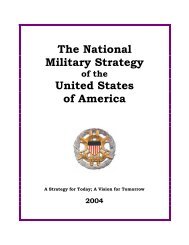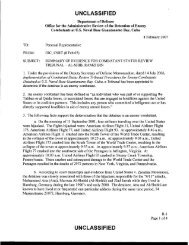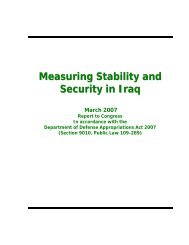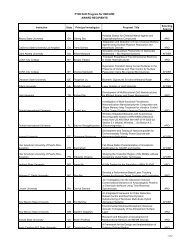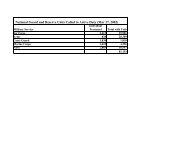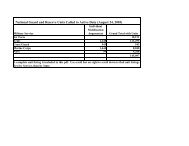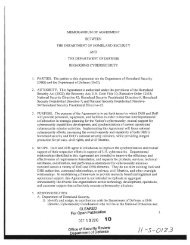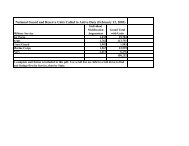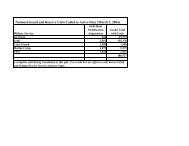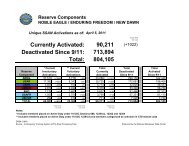Report - United States Department of Defense
Report - United States Department of Defense
Report - United States Department of Defense
You also want an ePaper? Increase the reach of your titles
YUMPU automatically turns print PDFs into web optimized ePapers that Google loves.
UNCLASSIFIED<br />
until they are able to conduct operations independently. In some cases, SFA Teams (SFATs) are<br />
supported by SFA Brigades (SFABs), which have replaced U.S. combat brigades as those<br />
brigades redeploy. SFABs are redesigned maneuver units that manage risk, oversee force<br />
protection and provide key support to SFATs when necessary. During the reporting period, six<br />
U.S. combat brigades were drawn down and eight SFABs were deployed.<br />
The SFAT model also reflects an evolution in how ISAF solicits partner nation troop<br />
contributions, moving from a focus on geographic areas <strong>of</strong> responsibility to a model more<br />
focused on ANSF unit sponsorship. Each SFAT is tailored to include individuals with specific<br />
skills associated with the ANSF unit to which it is assigned. Each troop-contributing nation<br />
determines its SFATs’ composition and disposition in order to meet ISAF requirements.<br />
Currently, the Supreme Headquarters Allied Powers Europe (SHAPE) has established<br />
requirements for 460 SFATs; as <strong>of</strong> the end <strong>of</strong> the reporting period there is a shortfall <strong>of</strong> 60<br />
SFATs. The near-term challenge for NATO is to enlist the support <strong>of</strong> troop-contributing nations<br />
that have specific and readily usable and transferable skill sets for SFATs. SFAT requirements<br />
will decrease through 2013 as the ANSF improves its ability to independently conduct<br />
operations.<br />
A Note on Metrics<br />
ISAF has always used a comprehensive approach to assessing the campaign by considering a<br />
wide array <strong>of</strong> metrics that address security, economic, governance and other trends. Public<br />
reports such as this have, however, placed too much emphasis on enemy-initiated attacks (EIAs)<br />
as a single measure <strong>of</strong> progress. As the nature <strong>of</strong> the conflict has evolved, it has become clear<br />
that a tally <strong>of</strong> EIAs is not now, nor was it ever, the most complete measure <strong>of</strong> the campaign's<br />
progress. At a time when more than 80 percent <strong>of</strong> EIAs are happening in areas where less than<br />
20 percent <strong>of</strong> Afghans live—a result <strong>of</strong> ISAF’s and the ANSF’s success in driving the<br />
insurgency out <strong>of</strong> populated areas—this single facet <strong>of</strong> the campaign has become significantly<br />
less relevant in evaluating progress against the insurgency. Improvements in the capabilities <strong>of</strong><br />
the ANSF and progress in governance and development are far more indicative <strong>of</strong> success in<br />
Afghanistan than the total number <strong>of</strong> EIAs. EIA trends, localized historical comparisons and a<br />
large number <strong>of</strong> other metrics are still accurate and are used throughout this report. This report<br />
will, however, no longer use nationwide EIA totals and historical comparisons <strong>of</strong> these totals as a<br />
main metric <strong>of</strong> success in Afghanistan.<br />
A key reason for this change in emphasis is that ISAF no longer has the ability to report most<br />
EIAs. As it shifts from a combat mission and as the number <strong>of</strong> forces in theater rapidly declines,<br />
ISAF is involved in a smaller share <strong>of</strong> tactical incidents that would be reported as compared with<br />
a year ago. Instead, EIAs are now primarily an ANSF reporting responsibility. Although EIA<br />
data are still a useable metric and comparisons with previous years are still valid under certain<br />
circumstances, the previous depth <strong>of</strong> analysis and assessments is no longer as central to assessing<br />
progress toward security and stability in Afghanistan.<br />
In January 2013, ISAF discovered that a number <strong>of</strong> EIAs reported from independent ANSF<br />
operations had not been included in its database. The ANSF had accurately reported these data,<br />
8



